Geometry | Chapter 5 | 8th Maths - Converse of Pythagoras Theorem | 8th Maths : Chapter 5 : Geometry
Chapter: 8th Maths : Chapter 5 : Geometry
Converse of Pythagoras Theorem
Converse
of Pythagoras Theorem
If in a triangle,
the square on the greatest side is equal to the sum of squares on the other two
sides, then the triangle is right angled triangle.
Example:
In the triangle
ABC,
AB2 + AC2 = 112 + 602 = 3721 =
612 = BC2
Hence, ∆ABC is a right angled triangle.
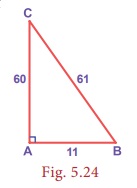
(i) There are special sets of numbers a, b and c that makes the Pythagorean
relationship true and these sets of special numbers are called Pythagorean triplets.
Example: (3, 4, 5) is a Pythagorean triplet.
(ii) Let k be any positive
integer greater than 1 and (a, b, c) be a Pythagorean triplet, then (ka, kb, kc)
is also a Pythagorean triplet.
Examples:
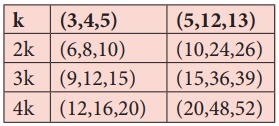
So, it is clear that we can have infinitely many Pythagorean triplets
just by multiplying any Pythagorean triplet by k.
We shall
now see a few examples on the use of Pythagoras theorem in problems.
Example 5.11
In the figure,
AB ⊥ AC
a) What type
of ∅ is ABC?
b) What are
AB and AC of the ∆ABC ?
c) What is
CB called as ?
d) If AC
= AB then, what is the measure of ∠ B and ∠C ?
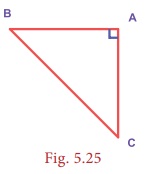
Solution:
a) ∆ABC is
right angled as AB ⊥
AC at A.
b) AB and
AC are legs of ∆ ABC .
c) CB is
called as the hypotenuse.
d) ∠ B + ∠ C = 90º and equal angles are opposite
to equal sides. Hence, ∠
B = ∠ C =90º /2 =45º
Example 5.12
Can a right
triangle have sides that measure 5cm,
12cm and 13cm?
Solution:
Take a = 5 , b = 12 and c =
13
Now, a 2 +
b2 =
52 + 122 = 25 + 144 =
169 =
132 = c2
By the converse
of Pythagoras theorem, the triangle with given measures is a right angled triangle.
Example 5.13
A 20-feet
ladder leans against a wall at height of 16 feet from the ground. How far is the
base of the ladder from the wall?
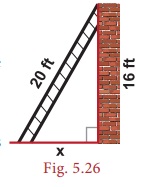
Solution:
The ladder,
wall and the ground form a right triangle with the ladder as the hypotenuse. From
the figure, by Pythagoras theorem,
202
=
162 + x2
⇒
400 =
256 +
x2
⇒ x2 = 400 − 256 = 144 = 122
⇒ x =12 feet
Therefore,
the base (foot) of the ladder is 12 feet away from the wall.
Activity
1. We can construct sets
of Pythagorean triplets as follows.
Let m and n be any two
positive integers (m > n):
(a, b, c) is a Pythagorean
triplet if a = m2 − n2 , b = 2mn and c = m2 + n2 (Think,
why?)
Complete the table.
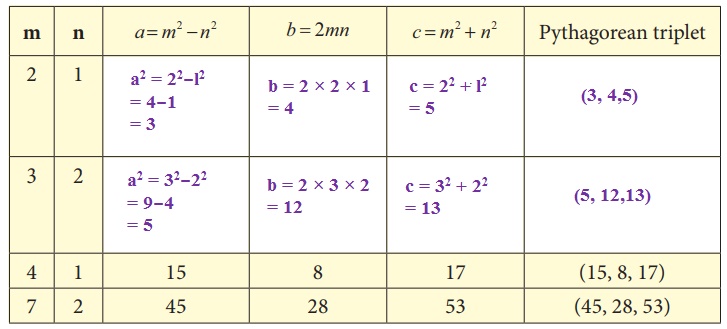
2. Find all
integer-sided right angled triangles with hypotenuse 85.
Solution:
(x + y)2 − 2xy = 852
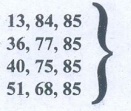 Pythagorean triplets with hypotenuse 85.
Pythagorean triplets with hypotenuse 85.
13, 84, 85
36, 77, 85
40, 75, 85
51, 68, 85
Example 5.14
Find LM,
MN, LN and also the area of ∆ LON.
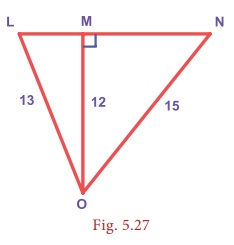
Solution:
From ∆LMO, by Pythagoras theorem,
LM2 = OL2 − OM2
⇒ LM2 =132 −122 =169 −144 = 25 = 52
∴ LM = 5 units
From ∆NMO, by Pythagoras theorem,
MN2 = ON2 − OM2
= 152 −122 = 225 −144 = 81= 92
∴ MN = 9 units
Hence, LN = LM
+
MN = 5 +
9 =
14 units
Area of ∆LON = 1/2 × base × height
= 1/2 × LN × OM
= 1/2 × 14 × 12 = 84 square units.
Example 5.15
∆ABC is equilateral
and CD of the right triangle BCD is 8 cm.
Find the
side of the equilateral ∆ABC and also BD.
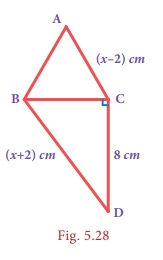
Solution:
As ∆ABC is
equilateral from the figure, AB=BC=AC= (x−2)
cm.
From ∆BCD, by Pythagoras theorem
BD2 = BC2 + CD2
⇒
( x + 2)2 =
( x − 2)2 +
82
x2 + 4x + 4 = x2 − 4x + 4 + 82
⇒
8 x = 82
⇒ x = 8cm
The side
of the equilateral ∆ ABC =
6 cm and BD =10 cm.
Related Topics